|
|
 Well, BLDGBLOG has taken to the road, now typing to you from California. 10 days in LA, Death Valley, Owens Lake, San Francisco... back March 8th, assuming my plane doesn't crash. Till then, in lieu of regular posting, I've put together a table of contents for new readers, old readers, bored readers, impatient readers – so click around, see what interests you, leave comments, forward to others, have fun. And if you have tips for what to do out here, of course, leave a comment below... Thanks!  Dismantling Gothic cathedrals arch by arch, on the beaches of an equatorial island! The world's largest diamond mine! Rollerskating alone at night through subterranean knots! A seed vault to avert planetary apocalypse! Listening to the arched foundations of London instrument! A man exactly reproduces his old apartment using colorful nylon sheets! Weird geometries in the Kansas farmscape! Slow landscapes of silt and the J.G. Ballard who loves them! The lost gods of Europe hurl spheres at each other in space! Valves, drains, and tunnels in the self-connected topology of underground London! Entire cities snowing diamonds from Baroque domes! Is that architecture or just a soundtrack hovering in space? Helicopter photographs in the sububs of self-similarity! The 7 New Wonders of the World! Southeast London transformed into a maze of rooftop gardens! A temporary public park – complete with bench and parking meter! Lunar electricity! The poet Shelley sets sail for a volcanic archipelago made entirely of glass! A London superstadium full of ring magnets will capture the Northern Lights! Beautiful maps!  The churches of Christopher Wren, transformed into a geomagnetic harddrive! The World Trade Center was actually a gigantic tuning fork! Jurassic park, Russian conservation style! James Bond thwarts a San Franciscan attempt at tectonic warfare! Slum dwellers and modular parasites of the urban world, unite! An abandoned island off the coast of Japan! Unearthly landscapes swarming with alien bacteria! The suburbs: raw mounds and earthworks, before construction arrives! Extraterrestrial life rained down on India! The internal volume of Notre-Dame, Paris, carved into the surface of the moon! Meat! The landscape architecture of Hell, its subsurface faults and magmatic geology! Why not live inside your garage? Is that a suburb growing out of your spine, or are you happy to see me? 3000km of concrete tunnels installed beneath the deserts of Libya! The robotic, neverending cinema of Los Angeles traffic control! A house of landslides, filled with geese! Hypnotic films of motorway orbitals now available on DVD! Measuring astronomy – solstice and stars – with a city modeled on Stonehenge! Unbelievable maps and diagrams of interstellar astral incidence!  Then we hiked alone for a thousand years, and we renamed all the constellations! The averaged images of suburban ennui! Food! Cake! Have you seen this hull before? New Arctic seaways promise Lovecraftian visions to come! On the colors of dismantled landscapes, photographed from the air! Famous architecture, blurred! Photographs of Chernobyl, including an abandoned alphabet! Morocco double-exposures! The Earth in 7.5 billion years! Fossilized cities! The art of reforesting continents through tree bombs! The deserts of the world are musical instruments! Venice resonates with voices! Huge and amazing maps of California hydrology! The city as an avatar of itself! The wonderfully weird, self-observing urban world of CCTV! Sci-fi instant cities built above working limeworks pits! The abandoned malls of Chicagoland! WWII British sound mirrors used to musicalize mountain storms! 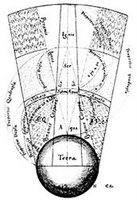 All hell is breaking loose in middle America! San Jellocisco! Catching near-earth asteroids using a gigantic baseball mit! If you've got nothing else to do, why not go camping in an abandoned mine? Inbred, zombified ex-idealists stumble through pressurized undersea utopias, listening to Mozart! Biking through glass tunnels suspended above metropolitan Toronto! An inflatable hotel – in deep space! Folk maps of Brooklyn's Gowanus Canal! Cool bridges! Houses, churches, places to hang: it's the afterlife of the Quonset hut! A man jumps from a balloon, free-falls 20 kilometers through the stratosphere, and captures the whole thing on film! King Kong! Complicated volcanic pipe networks will extrude cathedrals directly from the earth! Huge, interconnected white towers in the middle of Beijing! Arches National Park, Manhattan branch! Will the International Space Station soon be turned into a sculpture gallery? An Indonesian mine and the technicolor stalactites it will form in a million years! In a wilderness of mirrors we lost our own reflections! Recording the secret music of bridges! Amazing tree houses by Andrew Maynard!  That should hopefully last you a week... but don't forget the other posts, below – especially the Mars rover film. I'll be back!
Among the finalists for eVolo's recent design competition on the future of the skyscraper was Loren Supp. Having met Loren two years ago, I thought I'd get back in touch with him and ask a few questions about his project. 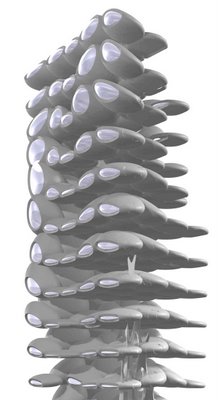 [Image: Loren Supp, Shanghai Vertical Marketplace, close-up of top floors]. First, some historical context: "In 1950 there were 86 cities in the world with a population over one million," Mike Davis writes; "today there are 400, and by 2015, there will be at least 550. Cities, indeed, have absorbed nearly two-thirds of the global population explosion since 1950 and are currently growing by a million babies and migrants each week. The present urban population (3.2 billion) is larger than the total population of the world in 1960. The global countryside, meanwhile, has reached its maximum population (3.2 billion) and will begin to shrink after 2020. As a result, cities will account for all future world population growth, which is expected to peak at about 10 billion in 2050." It seems obvious that this global hyper-urbanization will transform our species in unpredictable ways. Which is where Loren comes in. The skyscraper, he says, has become "the only viable architectural response" to such a future – but only after "a complete re-thinking of skyscraper iconography" has taken place. The "stacked plate mentality," in other words, "is about to go out the window." 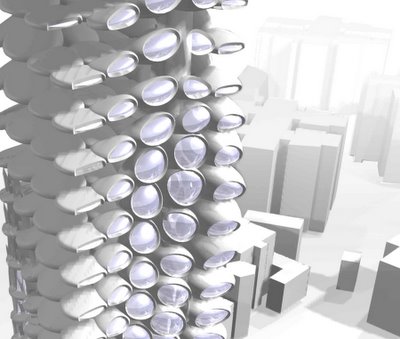 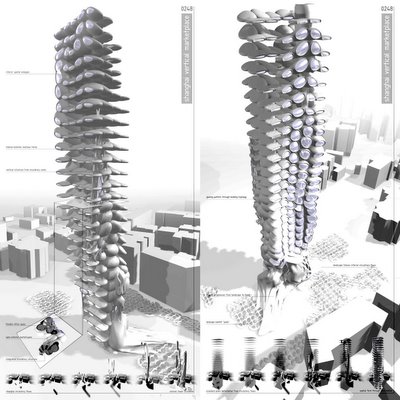 [Image: Loren Supp, Shanghai Vertical Marketplace, close-up with project display boards]. Loren's project is a "vertical marketplace" for central Shanghai. To generate its biomorphic structure and vaguely botanical contours, Loren "mapp[ed] the city's market economy" using "fluid dynamics software," which produced a complex diagram that "would have been impossible just a few years ago." The building is thus designed to fit into its "dynamically-constructed context." The building works as "an alleviation of the single-layer congestion that defines the horizontal cityscape. If you have ever been to Shanghai, one of the lasting impressions you take back is of the city's congested market economy. People sell everything, everywhere. The ultimate result of this phenomena is forced localization." Loren's tower, on the other hand – or perhaps a cluster of them, linked by gondolas (sorry) – would vertically stretch Shanghai's urban marketplace, growing a new, upward layering of the city. (Speaking of growing: look at the first image again, and you'll see a kind of internal buttressing, as if growing from pod to pod within the building).  [Image: Loren Supp, Shanghai Vertical Marketplace, close-up]. Design-wise, Loren says, the "only space made is that which is necessary. Uniting these 'exploded plates' with the market circulation that created them completes the skyscaper." Here, then, Loren's thinking what I'm thinking: "Can the project actually be built? That question will be answered through the same technological construct that allowed its design process. Complex formal architectures can, and will, be facilitated by the logic used in the software to visualize them. The terminology of isoparm, NURBS, and SubD, are infecting (and altering) the construction process, and the future of the skyscraper will inevitably depend upon them." So, perhaps some future questions for Loren in another post: Could there be such a thing as a prefabricated skyscraper? What might it look like? Could these towers be shortened – then clustered – yet still achieve the same urban effect? What about a single-family home – a whole suburb – of Shanghai Vertical Marketplaces? What would that look like...? For more of Supp's project – and many interesting others – stop by eVolo. Meanwhile, check out these frightening plans for a kilometre-high skyscraper in Kuwait; and take another look at the Beijing Boom Tower and the future urban-modular... (Originally spotted at Archinect).
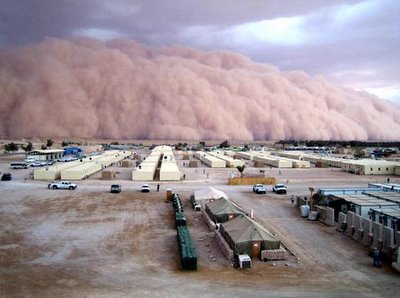 [Image: The earth is coming to get you... A dust storm in Iraq, via Pruned]. "Someday the U.S. military could drive a trailer to a spot just beyond insurgent fighting and, within minutes," we read, " reconfigure part of the atmosphere, blocking an enemy's ability to receive satellite signals, even as U.S. troops are able to see into the area with radar." They'll roll up, in other words – and throw storms at you... 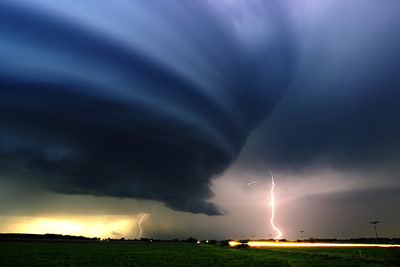 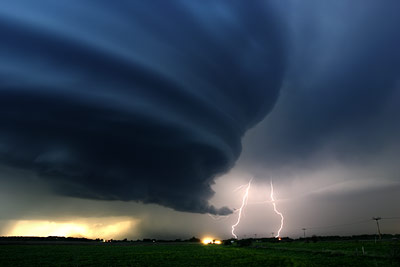 [Images: The Grand Island Supercell, photographed by Mike Hollingshead; these temporary parts of the earth, airborne geographies, surviving now only in photographs]. But imagine what an architect, or landscape architect, might do with such a thing: some atmosphere-reconfiguration technology disguised inside pillars, towers and arcades. An 18th c. English garden maze, lined with lichen-covered statuary, and each standing figure is an atmosphere-machine, generating clouds or clearing them. A cure for British weather. You can turn them all on, in the right order, fast enough, and form tornadoes. The murderer of birds, whirled to their doom. And if it's too close to Heathrow, your garden becomes a national security threat. Harry Potter and the Garden of Storms. 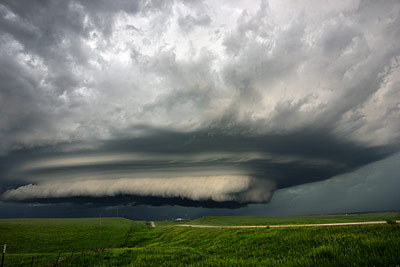 [Image: Another supercell, photographed by Mike Hollingshead]. A new tower is built in midtown Manhattan, attracting storms, upper floors constantly awash in sleeves of cloud cover. Ghostbusters III. Transmitters hidden inside marshland graveyards far east of London: Dracula Returns. Or none of the above, just a military unit on a border somewhere, staring through binoculars, preparing to hurl hurricanes, the grand wizardy of war: Bride of Climate Change. A weaponized earth. 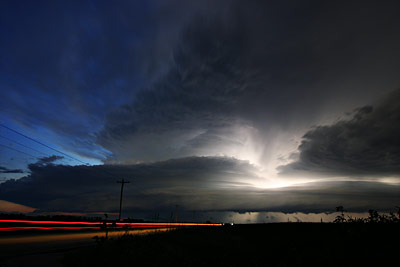 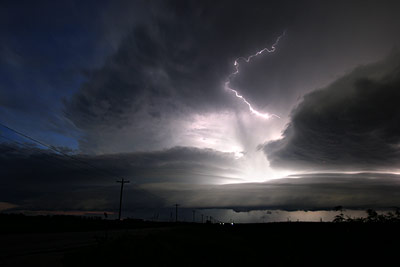 [Images: An almost theologically intense supercell, photographed by Mike Hollingshead].
A few months ago, BLDGBLOG explored suggestions by physicist Paul Davies that alien life may exist on Earth – though it would be unrecognizable to microbiologists, and thus ignored or wrongly identified.   Paul Davies now reviews a book by Peter Ward in New Scientist – and Davies writes some extraordinary things. The planets in our solar system, for instance, "are not completely quarantined from each other. Debris splattered into space by comet and asteroid impacts gets distributed around the solar system. Mars and Earth in particular have been trading rocks throughout their history, and it is clear that microbes could hitch a ride and be transported in relative safety from one planet to the other." Which could make for an award-winning Pixar film... Finding E. Coli. "Martian organisms might not be alien at all," Davies concludes, "but merely members of another branch on the terrestrial tree of life."  Even better is "the intriguing idea" – mentioned above – "that alien organisms may lurk all around us, unrecognised for what they are because they fail to respond to standard biochemical analysis" – or they're very bad at conversation. "For example, there could be microbes that use RNA instead of DNA, or employ a different genetic code." There is even a chance "that some viruses could be relics of ancient alternative forms of life." Which blows me away! In other words, an infection is really an encounter with ancient life. Living fossils inside injuries. But my enthusiasm here is ultimately more inspired by the possibilities for landscape design, say, using gardens as a form of astrobiological research. It's not a garden, it's a laboratory; it's not your backyard, it's a kind of skin graft from an alien planet, a celestial infection of the earth. Patches from elsewhere. J.G. Ballard's "nightmare world of competing organic forms" – an " insane Eden," indeed. One could even imagine a series of classified landscapes, grown by infrared in a cave beneath Los Alamos National Laboratory, incomprehensible genetic lines cultivated into a kind of aterrestrial Versailles. Fountains of amino acids washing slowly over alien flowers. Weird topiary mazes made of symmetrical creeper vines from space.  (For more of this, see BLDGBLOG's Alien Rain on India).
  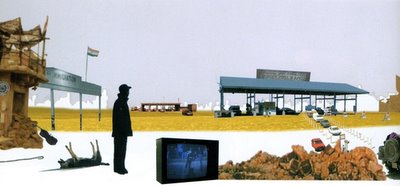  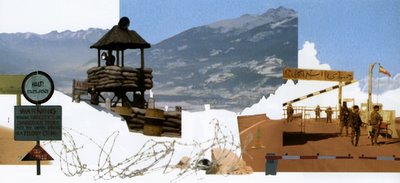 [Images: Borderville by Invertebrate; scanned from Issue #18 of Cabinet Magazine. These were "assembled out of objects ripped from (...) movies featuring border crossings," including Salvador, The Great Escape, Three Kings, Traffic, The Day of the Jackal, Not Without My Daughter, Bad Boys II, The Wild Bunch, From Dusk Till Dawn – etc. In other words, these are absolute borderlands, in-between spaces, a " backlash landscape" of political division. (Invertebrate: be in touch!)]. (Simultaneously posted on subtopia).
New York City's Mayor Michael Bloomberg recently announced an interest in building a network of gondolas across New York City. 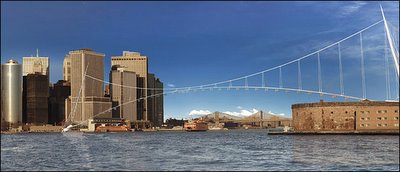 [Image: Santiago Calatrava]. Well... not quite a "network" – "across New York City" – but one route, "linking Brooklyn to Manhattan by way of Governors Island on a tramway." Governors Island, incidentally, is a small island in the New York harbor: "The city and state of New York bought the island in 2002 from the U.S. government for $1. Until 2000, it had been the longest continuously used U.S. military facility, dating back more than 200 years." $1!  [Image: Governors Island, upper left; Manhattan, upper right. The rest is Brooklyn. The gondola would go zipping back and forth]. In any case, the gondola, "estimated to cost $125 million, would be designed by the architect Santiago Calatrava, and would greatly change the face of Upper New York Bay. But there is a catch," we read: Bloomberg "acknowledged that the system was still only an idea. He said, however, that he hoped it would eventually become reality and in the meantime inspire others to come up with big ideas for the development of Governors Island." Like a Shakespearean theatre? Well, here's an idea: More routes. More gondolas. Gondolas you can rent as a live/work space. Private gondola routes, from high-rise to high-rise, with windows of bulletproof glass. Night-club gondolas. Church confessional gondolas. Flying prison cells, an Alcatraz of the sky, reforming criminals through scenic views. 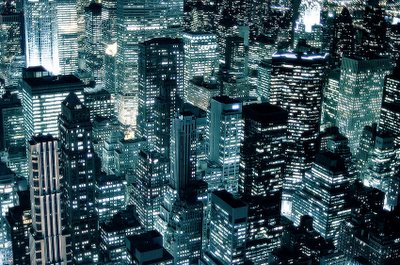 [Image: Keith Kin Yan]. Different architects and engineering firms should design the gondolas – Foster and Partners, Zaha Hadid, Michael Sorkin, Halcrow, even BLDGBLOG – and they shouldn't stop there: gondolas linking to gondolas, which in turn link to more gondolas. Gondolas switching through Ferris wheels. Gondolas connecting to the space elevator – which leads upward to gondolas in space... then back to Greenwich Village. Return trip: two hours. The city could recoup its investment by selling film permits to Hollywood. Die Hard 4. Gondola greenhouses that follow the sun in a heliocentric circuit round Manhattan, growing mutant flowers. An airborne hospital for the depressed. Rumors break out that there is a hidden gondola somewhere, itself unreachable by gondola – Kabbalists and Aristotelians argue that, in fact, this is impossible, citing Maimonides. Entire websites go up, dedicated to finding it. Folk maps are produced, printed in the back of Time Out, charting the fastest route, the most interesting route, the longest route, the scenic route. A listserv begins, describing gondola hacks: how to make your gondola do a 360º. You can win the Olympics with it.  [Image: Santiago Calatrava]. Alternatively, forget the gondolas: Governors Island, in its 172-acre entirety, should be uprooted, dismantled, geologically ground-down to soil and dust – then hung from a series of sacks and hammocks off the side of the Empire State Building. Hanging gardens, indeed. (Spotted at Archinect).
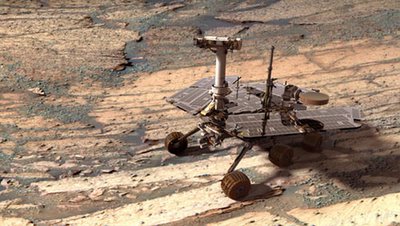 While editing a recent post about the Mars rover, I got to thinking – as you would – about how to make an animated, feature-length children's film, starring another such rover, set in the immediate future...  In the film, the rover would go tootling around in its cute little animated way, wheeling across unbelievable landscapes, snapping Ansel Adams-like photographs of alien tectonics, volcanoes and basins, systems of canyons that redefine the sublime. 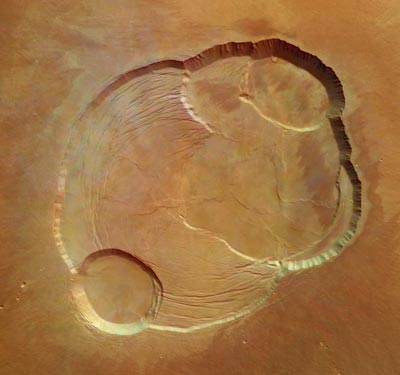 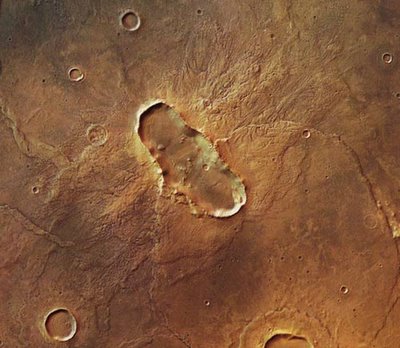  Hills, arches, gorges; mountains surrounded by clouds of methane. Erosion; windstorms; evidence of ancient floods. Plus, it's a cute little rover. Kids love the thing. They pressure their parents to name family pets after it. Burger King sells a small plastic version of it with their happy meals, or whatever they make there. T-shirts. Pajamas. 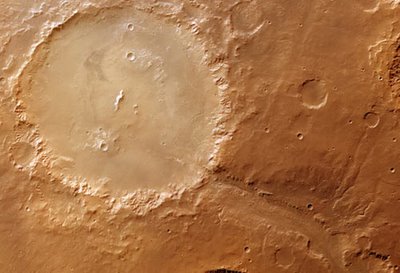 In any case, our erstwhile hero, the little rover, is Artificially Intelligent – and he's funny. Maybe his voice is by Paul Giamatti. And he gradually sort of wakes up, comes to consciousness, and falls head over heels – monitor over wheels – in love with the world, in love with landscapes, with everything – with emotion and memory – in love with love, and hope, and fear – and he starts to wax poetic over a radio-link back to mission control, his friends and creators, they're cheering, and to television viewers sitting on sofas at home, going on about how wonderful everything is. How beautiful that world, in which he travels alone, can really be. It's not lonely, see. He's on fire inside. His own little robot mind is as deep as the canyons he explores. He smiles. 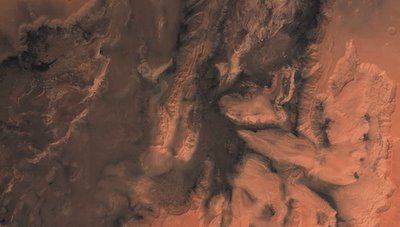 Kids in the cinema aren't blinking at this point; it's too amazing. Everyone's in love with this little rover. It's like bloody Dead Poets Society out there; everyone's feeling it. Everyone's alive. Cynics are vomiting into popcorn boxes. But then the Martian seasons change, and the rover has to shut down – to be shut down, by mission control. The kids in the cinema start to worry. Frowns appear. Dads grow nervous, re-crossing their legs, only vaguely reassured that the film is rated PG. You see people on-screen, back at mission control, wringing their hands, preparing to remotely shut off the rover – but the rover loves life, damn it, he loves what he's seeing, he wants to see more! He wants to live – and he's funny – and he's got a friend back at mission control who has to push the button, but she can't because she loves him – what do you mean shut him down?! – she loves his silly robot eyes, and his enthusiasm, and his stupid voice, and these amazing things he's been showing to everyone back on earth, and she can't do it. She can't kill the little guy. 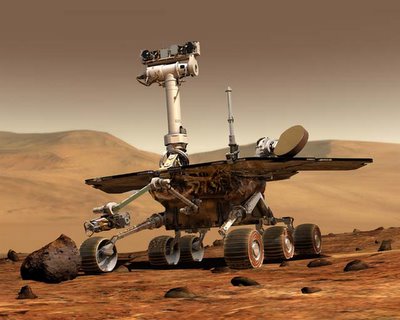 Some kids are crying now; she's crying. Not the little guy! With his tiny wheels pushing further into life and alien landscapes. Not him! Enter some sinister, technocratic boss figure – with a voice by Robert Duvall – and he forces her: the button is pushed, mission control sends the command, and our friendly, naive robot hero of off-planet landscape exploration, in the midst of a sad why are you doing this to me? weepy monologue, his AI-eyes wide and worried and scared of that darkness into which his circuits will go – overlooking the most beautiful canyon he's discovered so far – suddenly he is no more. 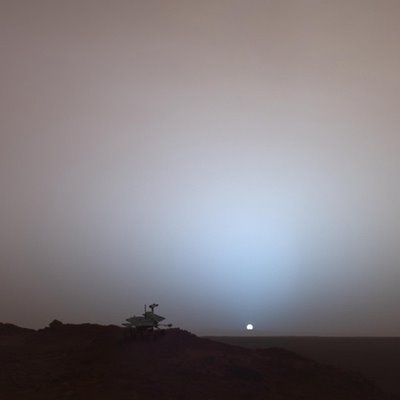 The rover's little eye-lights fade. Martian winds erase his tracks. Grown men wipe away tears before their wives can see them. The credits roll. Kids leave the cinema howling. Moms give out hugs left and right. Oscar nominations roll in. I retire to Arizona on the proceeds and begin carving strange topological forms into the desert floor. Movie producers: you know where to find me.
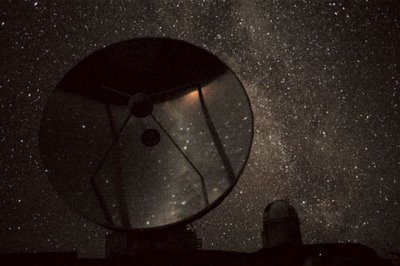 [Image: The Milky Way reflected in the dish of a derelict telescope, left unused and eroding in Chile's high Atacama Desert. Perhaps this is what night will look like in 10,000 years, after bird flu and nuclear terrorism, war and water shortages, have reduced humans to a few breeding pairs in the Arctic: a landscape of ruined pavilions once dedicated to space – Ballard's " deserted planetarium among the dunes" – beautifully lit by nothing but stars].
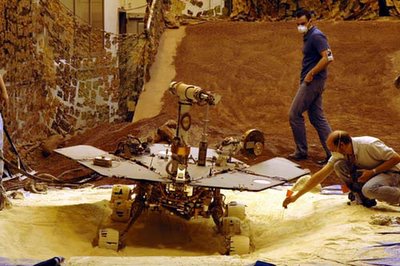   [Images: A " faux Mars" being air-brushed and constructed in a lab in southern California "to simulate the environment" on the red planet. Contrast that with a photo taken by Spirit, the robotic Ansel Adams of Mars, showing " Larry's Lookout, a pit stop along the robot's uphill trail as it explores the red planet." Pop quiz for conspiracy theorists: is Spirit really on another planet...?].
 [Image: It's back – and it's a real photo. "From space," we read, "Kansas farms look more like a geometric puzzle than sources of corn, wheat and other crops." From Earth, Kansas farms look more like ( censored)].
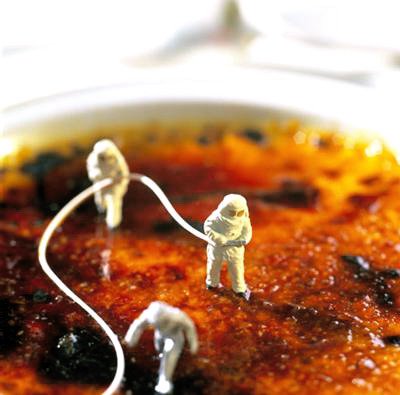 A friend of mine emailed, reminding me of an earlier post – then someone left a comment comparing BLDGBLOG to creme brulée. (I hope that's a good thing).  So I decided to revisit the world of dessert landscapes.  Yes, dessert landscapes. 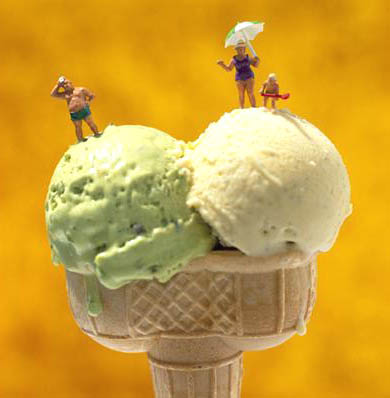 These are all culinary creations by Akiko Ida and Pierre Javelle, whose own website is both handicapped by excess Flash and chock full o' chocolate goodness. 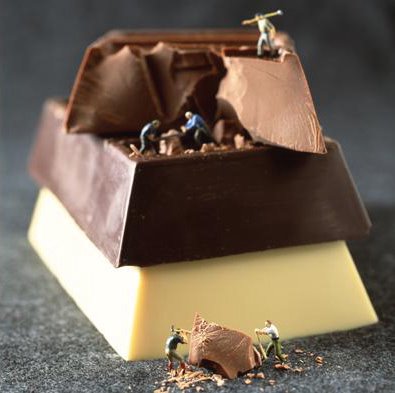  The pair have used kiwis, pastries, mushrooms, watermelons – and, of course, more desserts. But to sidestep the Flash agony, check out this blog for more images – or just look through BLDGBLOG's own earlier review. 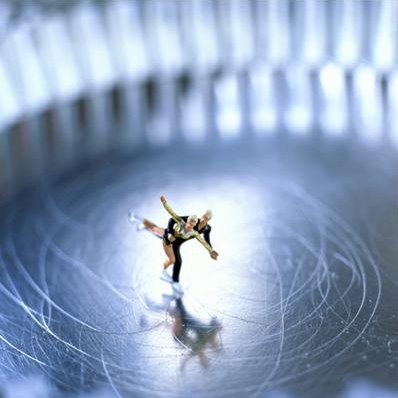 (Thanks, Megg! Foodscapes originally spotted back in October through things magazine).
|
|






















































